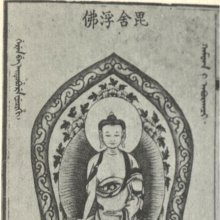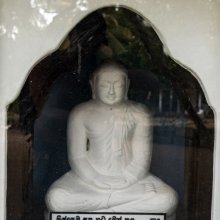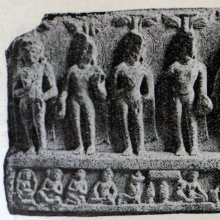Vishvabhu, Viśvabhū: 9 definitions
Introduction:
Vishvabhu means something in Buddhism, Pali, Hinduism, Sanskrit. If you want to know the exact meaning, history, etymology or English translation of this term then check out the descriptions on this page. Add your comment or reference to a book if you want to contribute to this summary article.
The Sanskrit term Viśvabhū can be transliterated into English as Visvabhu or Vishvabhu, using the IAST transliteration scheme (?).
Images (photo gallery)
In Hinduism
Ayurveda (science of life)
Toxicology (Study and Treatment of poison)
Source: Shodhganga: Kasyapa Samhita—Text on Visha ChikitsaViśvābhū (विश्वाभू) is the name of an ingredient used in the treatment of snake-bites such as those caused by the Kṛṣṇamaṇḍalī-snakes, according to the Kāśyapa Saṃhitā: an ancient Sanskrit text from the Pāñcarātra tradition dealing with both Tantra and Viṣacikitsā—an important topic from Āyurveda which deals with the study of Toxicology (Viṣavidyā or Sarpavidyā).—Accordingly, one of the treatments is mentioned as follows: “For the fire-like burning of the wound caused by the bite, a paste or bolus made out of the excreta of pigeon, sap of Kapittha, Viśvābhū and Girikarṇikā must be applied on it with the dry leaves of Aśvamāra. Ash (bhasma) gotten from burnt rice must be applied on the body. It can be used for fumigation too”.

Āyurveda (आयुर्वेद, ayurveda) is a branch of Indian science dealing with medicine, herbalism, taxology, anatomy, surgery, alchemy and related topics. Traditional practice of Āyurveda in ancient India dates back to at least the first millenium BC. Literature is commonly written in Sanskrit using various poetic metres.
In Buddhism
Mahayana (major branch of Buddhism)
Source: Wisdom Library: Maha Prajnaparamita SastraViśvabhū (विश्वभू) or “victorious over all” is the name of a Buddha according to the according to the 2nd century Mahāprajñāpāramitāśāstra (chapter XV).—Accordingly, “One thing that is difficult to find is a Buddha Bhagavat. It takes innumerable koṭi of kalpas to find one. In 91 kalpas, there have been only three Buddhas. Before the good kalpa (bhadrakalpa), during the 91st kalpa, there was a Buddha called Vipaśyin, “views of all kinds”; during the 31st kalpa, there were two Buddhas; the first was called Śikhin, “fire”, and the second Viśvabhū, “victorious over all”. During the good kalpa, there were four Buddhas, Krakucchanda, Kanakamuni “golden sage”, Kaśyapa and Śākyamuni. Except for these kalpas, all the others were empty (śūnya), lacking Buddhas and miserable”.

Mahayana (महायान, mahāyāna) is a major branch of Buddhism focusing on the path of a Bodhisattva (spiritual aspirants/ enlightened beings). Extant literature is vast and primarely composed in the Sanskrit language. There are many sūtras of which some of the earliest are the various Prajñāpāramitā sūtras.
Tibetan Buddhism (Vajrayana or tantric Buddhism)
Source: archive.org: The Indian Buddhist IconographyViśvabhū (विश्वभू) refers to one of the seven mortal Buddhas (mānuṣī) whose names appear last in the list of thirty-two Buddhas in Mahāyāna Buddhism.—The last seven Tathāgatas are well-known, and are designated by the Mahāyānist as Mānuṣī or “Mortal Buddhas”. When represented, the last seven Mortal Buddhas appear all alike; they are of one colour and one form, usually sitting cross-legged,with the right hand disposed in the Bhūmisparśa-mudrā (earth-touching attitute), which is the mudrā peculiar to Akṣobhya. [...] In paintings, the Mortal Buddhas [viz., Śikhī] have usually a yellow or golden complexion. [...] Sometimes they are represented as standing, in which case the appear under a distinguishing Bodhi Tree and with a distinguishing mudrā.
Viśvabhū is associated with the (Mortal) Buddhaśakti named Viśvadharā, and together they bring into existence the (Mortal) Bodhisattva named Ākāśagañja.

Tibetan Buddhism includes schools such as Nyingma, Kadampa, Kagyu and Gelug. Their primary canon of literature is divided in two broad categories: The Kangyur, which consists of Buddha’s words, and the Tengyur, which includes commentaries from various sources. Esotericism and tantra techniques (vajrayāna) are collected indepently.
General definition (in Buddhism)
Source: Wisdom Library: Dharma-samgrahaViśvabhū (विश्वभू) refers to the third of the “seven Buddhas” (saptatathāgata) as defined in the Dharma-saṃgraha (section 6). The Dharma-samgraha (Dharmasangraha) is an extensive glossary of Buddhist technical terms in Sanskrit (e.g., saptatathāgata and Viśvabhū). The work is attributed to Nagarguna who lived around the 2nd century A.D.
Languages of India and abroad
Sanskrit dictionary
Source: Cologne Digital Sanskrit Dictionaries: Edgerton Buddhist Hybrid Sanskrit DictionaryViśvabhū (विश्वभू).—also, more rarely, °bhuj (= Pali Vessa-bhū), name of a former Buddha, regularly third of the ‘seven Tathāgata’ (q.v. for refs.), immediate predecessor of Krakucchanda; Tibetan on Lalitavistara 5.15 (°bhuvā, instr.) thams cad (all) skyobs (help, which hardly renders either -bhū or -bhuj): Mahāvastu i.294.19; iii.240.7 f.; 243.15; 244.6; 246.8 (°bhuvasya, gen., mss.); 247.10; 249.5; Kāraṇḍavvūha 24.14; (Ārya-)Mañjuśrīmūlakalpa 426.9 (prose; °bhuvā, instr.); Gaṇḍavyūha 206.12.
Source: Cologne Digital Sanskrit Dictionaries: Shabda-Sagara Sanskrit-English DictionaryViśvabhū (विश्वभू).—m.
(-bhūḥ) The third of the seven Bud'dhas, according to some systems. E. viśva all, and bhū being.
Source: Cologne Digital Sanskrit Dictionaries: Monier-Williams Sanskrit-English Dictionary1) Viśvabhū (विश्वभू):—[=viśva-bhū] [from viśva] m. Name of a Buddha, [Dharmasaṃgraha 6.]
2) Viśvābhū (विश्वाभू):—[=viśvā-bhū] [from viśvā > viśva] mfn. being in everything or everywhere, [ib.]
Source: Cologne Digital Sanskrit Dictionaries: Yates Sanskrit-English DictionaryViśvabhū (विश्वभू):—[viśva-bhū] (bhūḥ) 3. m. The third of the seven Buddhas.
[Sanskrit to German]
Sanskrit, also spelled संस्कृतम् (saṃskṛtam), is an ancient language of India commonly seen as the grandmother of the Indo-European language family (even English!). Closely allied with Prakrit and Pali, Sanskrit is more exhaustive in both grammar and terms and has the most extensive collection of literature in the world, greatly surpassing its sister-languages Greek and Latin.
See also (Relevant definitions)
Starts with: Vishvabhuj, Vishvabhuja, Vishvabhuk, Vishvabhuta, Vishvabhutalokeshvara, Vishvabhuti.
Full-text: Vipashyin, Visvadhara, Akashaganja, Sikhin, Seven Buddhas, Saptatathagata, Kapittha, Kapitthasthi, Bhasma, Tandulibhasma, Ashvamara, Krishnamandali, Manushi, Vessabhu, Tathagata, Vishvakarma.
Relevant text
Search found 8 books and stories containing Vishvabhu, Viśvabhū, Visvabhu, Vishva-bhu, Viśva-bhū, Visva-bhu, Viśvābhū, Viśvā-bhū; (plurals include: Vishvabhus, Viśvabhūs, Visvabhus, bhus, bhūs, Viśvābhūs). You can also click to the full overview containing English textual excerpts. Below are direct links for the most relevant articles:
The Great Chariot (by Longchenpa)
Part 5 - Teaching impermanence through teaching how the victorious ones and their sons attain nirvana < [B. The extended explanation]
The Indian Buddhist Iconography (by Benoytosh Bhattachacharyya)
The Mahavastu (great story) (by J. J. Jones)
Chapter XXI - Former Buddhas < [Volume III]
Chapter XXIX - The Buddha in Veśālī (Vaiśālī) < [Volume I]
Maha Prajnaparamita Sastra (by Gelongma Karma Migme Chödrön)
II. Real longevity of the buddhas < [Part 16 - Obtaining the immense longevity and immense radiance of the Buddhas]
5. The four ‘vilokanas’ and the entry into the womb < [Part 4 - The Bodhisattva in the Abhidharma system]
Act 9.2: Examination of the plurality of Buddha < [Chapter XV - The Arrival of the Bodhisattvas of the Ten Directions]
Manasara (English translation) (by Prasanna Kumar Acharya)
Related products


